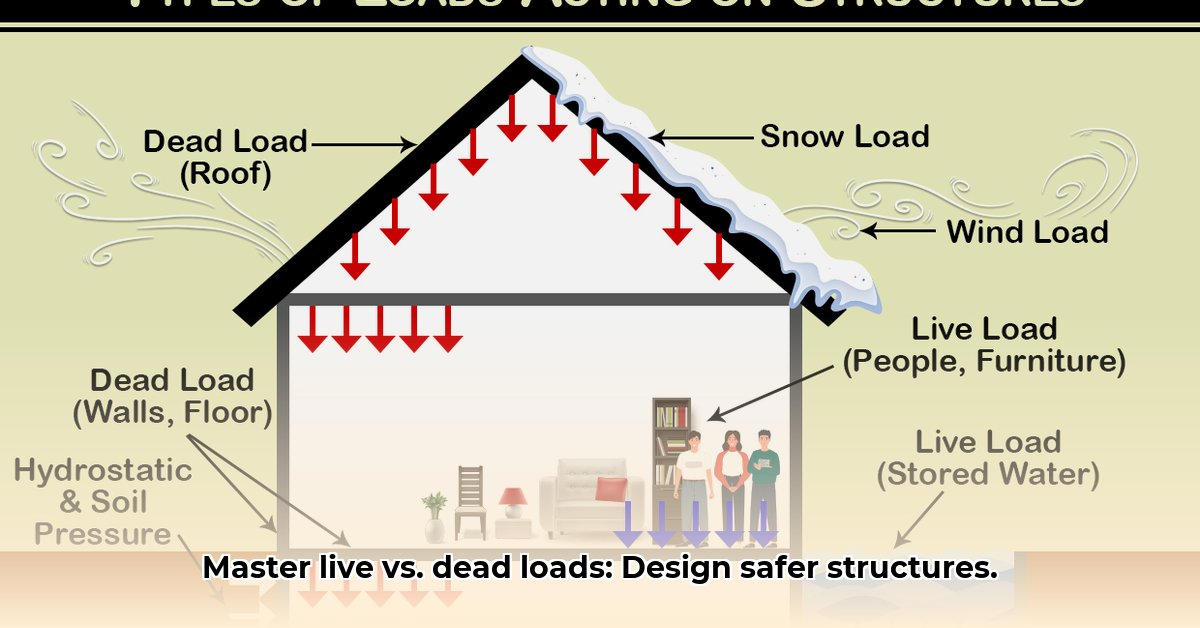“`markdown
Master Live Load vs Dead Load: Design Safer Structures Now
Let’s talk about the unseen forces that shape our buildings – the weights and pressures that structures silently bear. Understanding the difference between live load and dead load is critical for building safe and stable structures, whether you’re an engineer, architect, or simply curious about how buildings stay upright. Ignoring this fundamental concept can have serious consequences for structural integrity. For deeper insights into structural dynamics, see this helpful resource on natural frequencies.
Dead Loads: The Building’s Permanent Weight
Imagine the bones of a building. That’s essentially what dead load represents: the permanent, unchanging structural load of the structure itself. This includes everything that’s permanently attached: the walls, floors, ceilings, roof, plumbing, electrical wiring, fixed appliances, and any built-in fixtures. It’s the constant pressure the building always has to manage, a key factor in building design. Calculating dead load is a relatively straightforward process.
Calculating Dead Loads: A Step-by-Step Guide
- Identify the Components: List every permanent structural element – each wall section, floor slab, beam, column, roofing material, etc. Be thorough; accuracy is paramount for reliable structural analysis.
- Measure the Dimensions: Carefully measure the dimensions of each component. We need precise volumes to proceed, so use accurate measuring tools to minimize measurement errors.
- Find the Material Densities: Consult engineering handbooks or material specifications to find the density (weight per unit volume) of each material used. Common resources include the American Institute of Steel Construction (AISC) Steel Construction Manual, or the Portland Cement Association (PCA) for concrete. Different materials – concrete, steel, wood – have different densities, affecting the overall structural weight.
- Calculate the Volume: Determine the volume of each component using the appropriate geometric formulas (e.g., volume of a rectangular prism = length x width x height). Ensure consistent units (e.g., inches, feet, meters) for accurate results.
- Calculate the Weight: For each component, multiply its volume by its density. This gives you the weight of that individual component. Remember to keep consistent units throughout the process (e.g., cubic feet and pounds per cubic foot) for accurate weight calculation.
- Add Up the Weights: Finally, sum the weights of all the components together to get the total dead load for the structure. This is the total permanent weight the structure always supports and helps determine load bearing capacity.
The seemingly simple process above requires attention to detail. A small error in measurement or material density can significantly affect the final dead load calculation, leading to an inaccurate assessment of the building’s structural integrity.
Live Loads: The Changeable Weights
Now, let’s consider the “guests” at the party – the ever-changing weights and forces that the building supports. This is the realm of live loads. These are temporary forces that vary over time. Live loads include things like the weight of people, furniture, equipment, stored materials, snow (in snowy areas), rain, wind, and even the impact of moving vehicles (for bridges). The dynamic nature of a live load makes calculating it more complex than dead load; understanding load variability is crucial.
Factors Affecting Live Load Calculation
- Building Occupancy: A library will have drastically different occupancy loads than a concert hall or a warehouse. The expected number and density of occupants significantly influence calculation. Refer to ASCE 7 for specific occupancy load requirements.
- Building Codes: Local and national codes dictate minimum live load allowances for different building types and locations. These codes are not just suggestions; they’re legal requirements designed to ensure public safety. These codes often account for worst-case scenarios and potential code violations. Common codes include the International Building Code (IBC) and ASCE 7.
- Environmental Loads: Snow load is a major concern in regions with heavy snowfall; high winds impact tall buildings; and fluctuating water levels affect structures near water bodies. Wind loads are calculated according to ASCE 7, considering factors like wind speed and building height. Consider all environmental factors relevant to your location when addressing environmental stresses.
- Maintenance Loads: Consider loads imposed during maintenance, such as equipment or materials temporarily placed on the roof.
Calculating Live Loads: A More Nuanced Approach
While calculating dead load is a relatively direct process, calculating live loads requires more interpretation and engineering judgment. Live load calculations rely heavily on building codes and standard practices. Your calculations should conform to these codes, using standard load factors for the specific types of live load applicable to your project. For example, codes often specify minimum live loads for residential, commercial and industrial spaces. Special considerations may be needed for unusually high live loads, such as in storage facilities, impacting load distribution.
The Combined Effect: Dead Load + Live Load = Structural Integrity
Think of it this way: a bridge supports its own weight (dead load) and the weight of cars driving across it (live load). The structure must withstand both simultaneously. The combined effect is far greater than the sum of its parts. This is why combined load analysis is crucial – it considers how the dead and live loads interact to produce the total stress on the structure. Often requiring combined load calculations.
Sophisticated software and experienced engineers typically handle this analysis. They create models to simulate how the building responds to different load combinations, ensuring it remains safe and stable under all foreseeable conditions. Simplified methods, suitable for less complex structures, may also be used, aiding in structural safety. Load combinations are typically defined in building codes such as ASCE 7.
Safety Factors and Building Codes: The Guardian Angels
Building codes aren’t optional; they’re legal frameworks designed to ensure structural safety. They incorporate safety factors, which essentially inflate the calculated loads. This produces a built-in margin of safety to account for unforeseen circumstances, inaccuracies in calculations, material imperfections, and other uncertainties. Always design according to the applicable codes in your area; shortcuts are dangerous and illegal due to the elevated level of structural risk.
Advanced Analysis: Delving Deeper
For intricate structures, engineers often turn to advanced computational methods and tools. Finite element analysis (FEA) is one such method. It uses sophisticated computer models to simulate the behavior of the structure under different load combinations. This allows engineers to analyze the stress and strain throughout the structure and identify potential weak points. This method is particularly useful for complex geometries and high-load scenarios, using sophisticated engineering software. Software packages like ANSYS or SAP2000 are commonly used for FEA.
Key Differences at a Glance
| Feature | Dead Load | Live Load |
|---|---|---|
| Nature | Permanent, Static | Temporary, Variable |
| Source | Structure’s components and materials | Occupants, equipment, environmental factors |
| Predictability | Consistent and easily predictable | Highly variable and less predictable |
| Calculation | Relatively straightforward | More complex, often using building codes |
| Impact on Design | Determines minimum structural requirements | Influences the size and capacity of structural elements |
Understanding the interplay of live and dead loads is paramount for creating safe and reliable structures. It’s not just a theoretical exercise; it’s a crucial aspect of responsible engineering, reducing risks and ensuring public safety through effective load management. Ongoing research continues to refine our understanding and adapt our methods to new challenges and technologies. The field is constantly evolving, so staying updated with the latest best practices is essential for responsible structural engineering.
How to Calculate Live Loads for Complex Building Designs
Key Takeaways:
- Accurate load calculations are crucial for safe and efficient building design.
- Dead load calculations are relatively straightforward, providing consistent structural weight.
- Determining appropriate live loads requires careful consideration of building codes, occupancy type, and potential future uses, ensuring occupancy safety.
- Environmental loads vary significantly by location and require regional building code adherence, addressing potential environmental stresses.
- Understanding load combinations and safety factors is critical to ensure structural safety in structural engineering.
Understanding Dead Loads
Dead loads are the constant weight of the building’s permanent components. Think of it like the skeleton of your building. It’s the weight of the structural frame, floors, walls, roofing materials, and fixed installations, forming the building skeleton. Calculating dead loads is usually a straightforward process of determining the volume and density of these elements and multiplying them for precise weight calculation. Ensure you include all significant permanent elements such as façade components, mechanical and electrical equipment.
Mastering Live Loads: The Challenge
Live loads are the dynamic, variable forces acting on a structure. These include the weight of people, furniture, equipment, and stored materials. Unlike dead loads, live loads are unpredictable and vary greatly depending on the building’s intended use and occupancy. This makes how to calculate live loads for complex building designs a crucial skill, contributing to the dynamic forces assessment.
Calculating Live Loads: A Step-by-Step Guide
The complexity increases exponentially as you move from simple structures to complex ones. Let’s break down the process:
- Identify Occupancy: What will the building be used for? (Residential, office, warehouse, etc.) This determines the appropriate live load values by referring to the occupancy type. Consider potential multiple occupancies within the same structure.
- Consult Building Codes: Refer to relevant building codes (like ASCE 7-16 or the International Building Code)
















